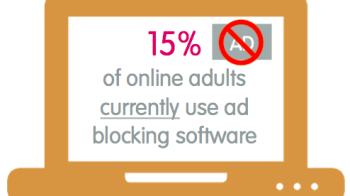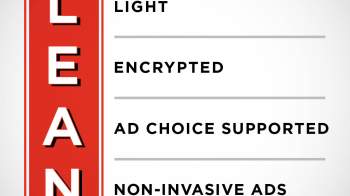Ad blocking: Quick fix or devastating trend?
Dave Reed
Dave Reed, Managing Director of EMEA at MediaMath looks at the affect of ad blockers on the free web.
Ad blockers are a short-term fix to a long-term issue. They are, however, causing considerable damage to the free web during their moment in the spotlight – encouraging consumers to unwittingly stifle the very content they seek.
Ad blockers are pieces of software that remove advertising from a webpage and can be installed by consumers who find digital ads annoying, intrusive or irrelevant. They also improve consumers’ online experience by eliminating the tech-heavy tags, plug-ins, and analytics that come with online advertising and which significantly slow down web browsing. You’d be forgiven for thinking this sounds fairly reasonable – and the one in ten users who signed up to ad blockers at the end of last year apparently agree – but there’s a serious issue with ad blocking which will prevent it occupying a permanent position in the economy of the web.
So where is the harm in ad blocking and what is the alternative?
Although fewer than half of UK consumers realise it, the vast majority of the free online content we access daily is funded by advertising. Producing content is an expensive business for publishers and it is primarily financed by charging brands for the privilege of advertising to you, the consumer. Ad blockers disrupt this value exchange, leaving publishers footing the bill for consumer content without getting anything in return, meaning the rise of ad blocking poses a real threat to the free web as we know it.
Digital ad revenue doesn’t just fund online content; it also provides a revenue stream for research and development that is rarely recognised. Google is one of the top ten big spenders globally when it comes to research and development. While some of its projects such as self-driving cars and connected glasses may seem a little wacky now, by using ad revenue in this manner, Google is laying the technological foundations for tomorrow’s connected world.
Publishers are finding their own ways to deal with ad blocking. Many are giving in and paying ad blocking software developers to whitelist their sites so advertising passes through the filters and is displayed – an ambiguity that poses serious questions about the integrity of the ad blocking concept. Some content providers are taking a firmer stand, with advertiser-funded newspapers and broadcasters such as City A.M. and Channel 4 obstructing users from their content if they are using ad-blocking software. One in four City A.M. readers have apparently turned off their ad blockers as a result of this action. Forbes is also preventing users of ad blockers from accessing its content, and is offering a 30-day ‘ad light’ experience once ad blockers are disabled. Other publishers are taking a softer approach. The Guardian is asking users of ad blockers to consider taking a paid subscription to the site, but ironically these messages to readers are frequently blocked by the very software they concern.
The Guardian’s current approach raises an interesting question around whether – with the ongoing consumer backlash against digital advertising – a paid subscription service might be a viable alternative to funding online content. Well the short answer to that question is “no”. Overall it’s estimated an ad-free internet would cost each user approximately £140 per year, which the majority would be unwilling to pay. Even if consumers were prepared to pay, managing logins and subscriptions for each different news publication, social media site, cookery blog, or health website would be detrimentally complex. Many content providers are testing out pay-for-access services – YouTube Red is one such example – but the model is untenable across the entire web. The fact that Spotify has 75 million active users on its ad-supported music streaming service and only 20 million paying to access the ad-free version speaks for itself.
It’s easy to see why certain models won’t work, but coming up with an alternative is more problematic. An opt-in system is often suggested but it’s unrealistic to expect consumers to opt into all advertising when there is no obvious incentive for them to do so, and – in the current climate of intrusive, irritating advertising – the draw simply isn’t there. Advertising doesn’t have to be annoying or irrelevant and – if done properly – it can be both valuable and enjoyable for the consumer, which is where the solution to ad blocking lies.
Consumers need a far stronger voice in the debate over how online advertising should work, and publishers such as The Guardian have hinted at future solutions to ad blocking that put the user in control. Rather than being obliged to choose between all or nothing, consumers should be given the opportunity to opt into good advertising and opt out of bad, rewarding ads they find relevant, meaningful or entertaining, and blocking those they find irritating. For example, a personalised targeted creative showcasing the latest collection from your favourite clothing brand is unlikely to irritate you, whereas a standard-issue ad for car insurance served to a consumer who doesn’t even own a car will almost certainly be blocked. The result will be a form of natural selection in the digital advertising industry, where those advertisers who use data to make smart, real-time decisions about what their customers want in any particular context will thrive, and those that are unable to improve the customer experience will fail.
Advertising is vital to the sustainability of the free web, and it’s clear a solution is required to force advertisers to improve their game in terms of ad quality and relevance. Ad blocking does not provide the answer, but until consumers understand the inherent dangers of ad blocking and a more viable option is available, consumers will continue to blanket block online advertising, unwittingly choking the content we value so highly.
Related content
Ad blocking software - consumer usage and attitudes
Learn moreIAB Ad Blocking FAQs 2016
Learn moreIAB UK launches principles to address Ad Blocking
Learn moreAdform: Six new consumer-friendly formats in response to the rise in ad blocking
Learn more
Rediscover the joy of digital advertising
Champion connections instead of clicks. Capture audiences' imaginations, not just their attention. Boldly find your own beat instead of letting tech set the pace. It’s time to rediscover the joy of digital.



